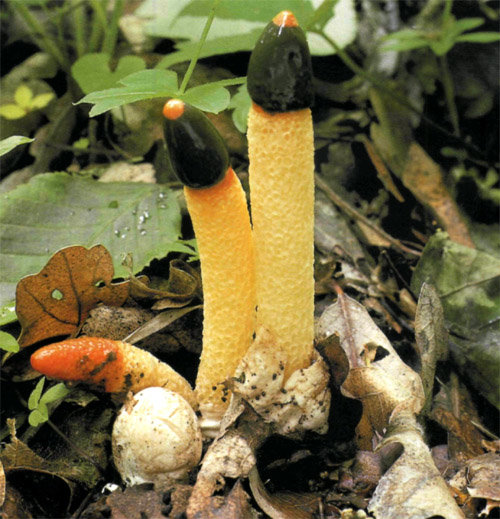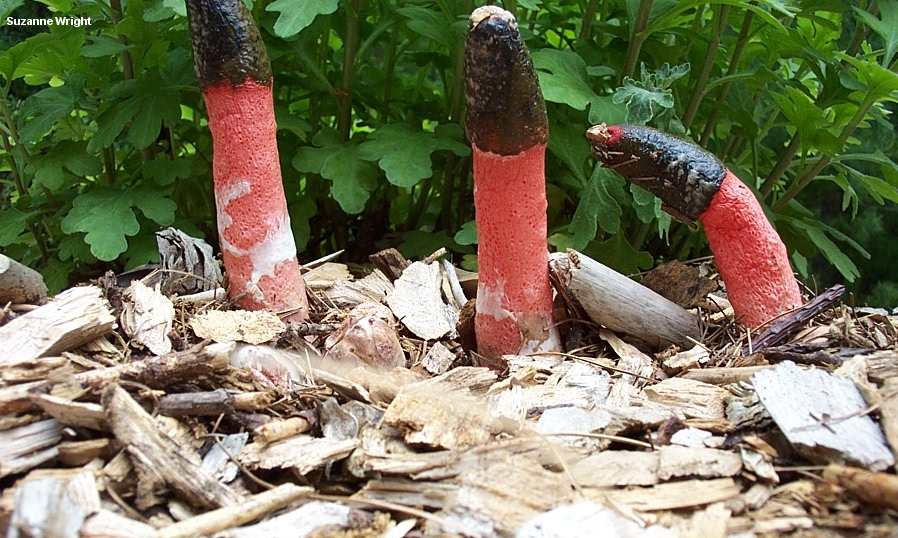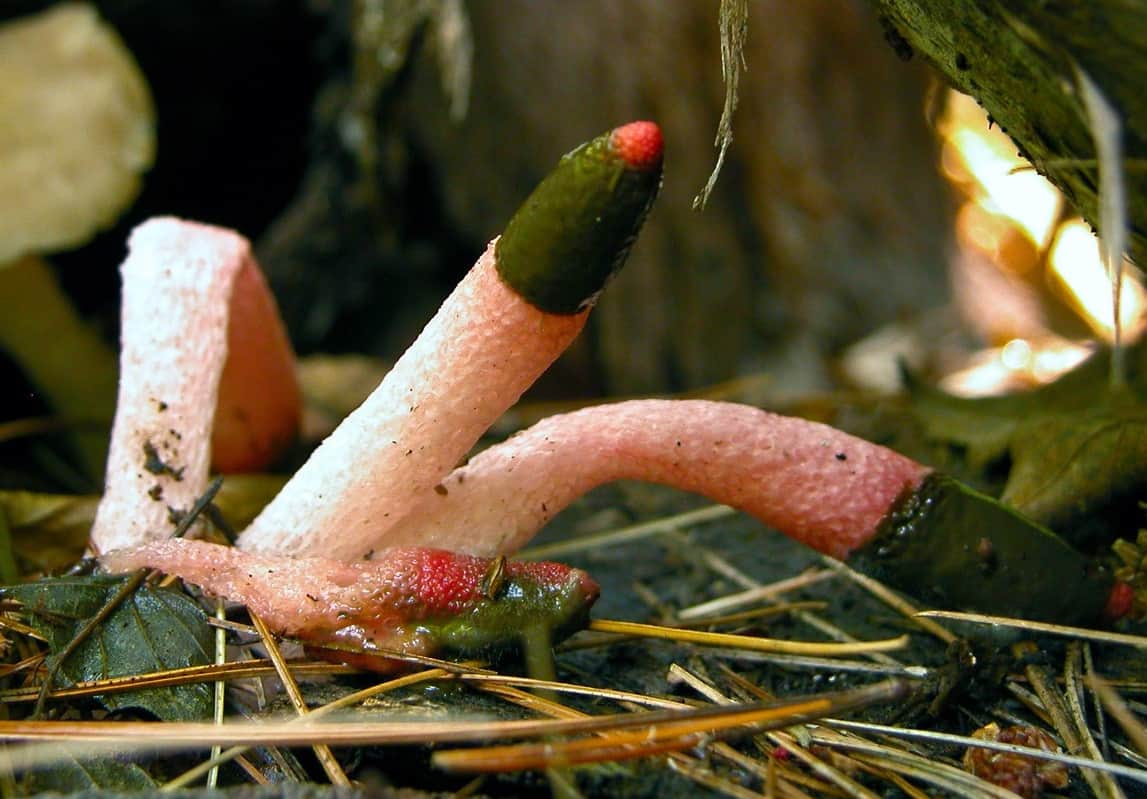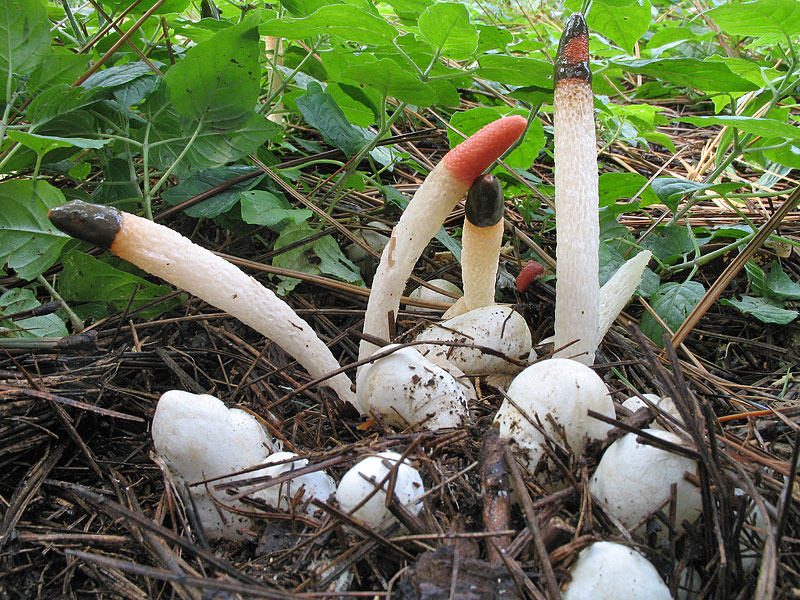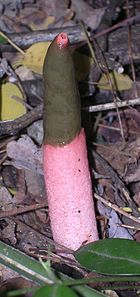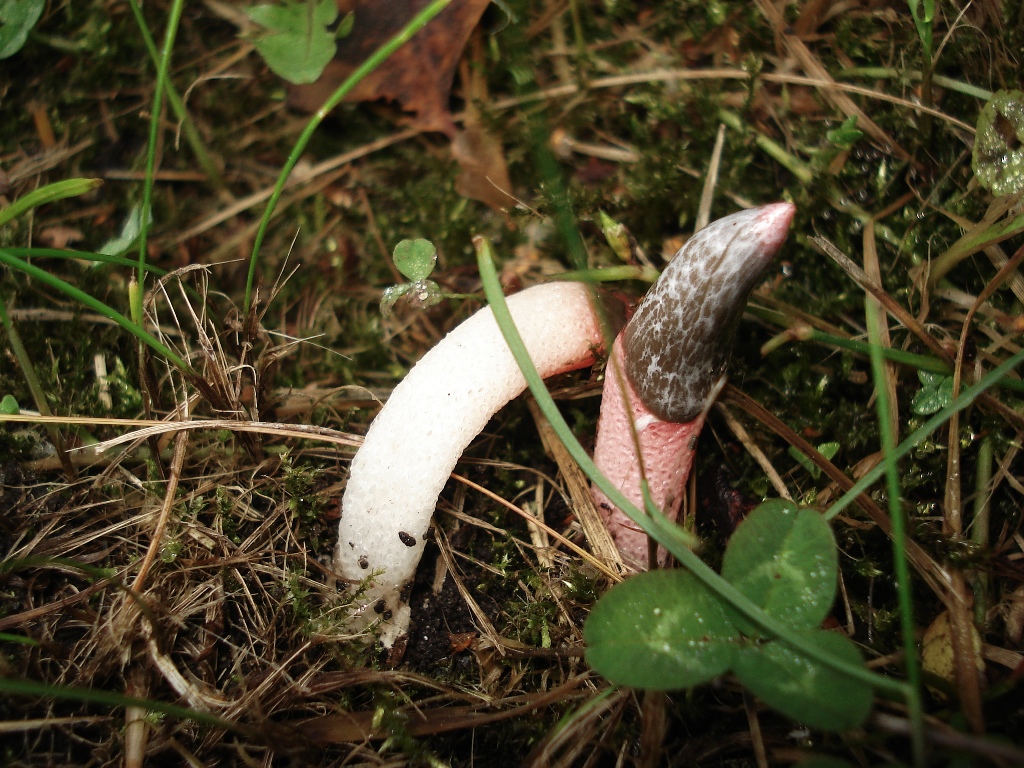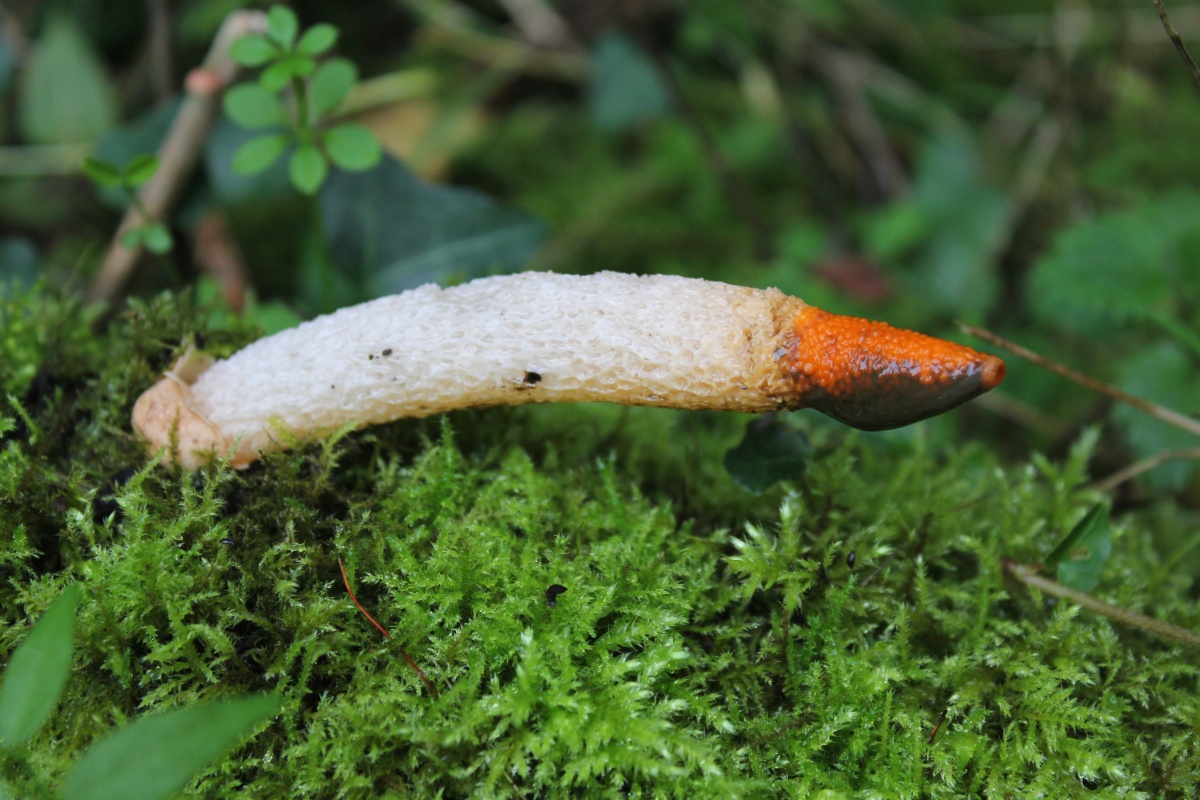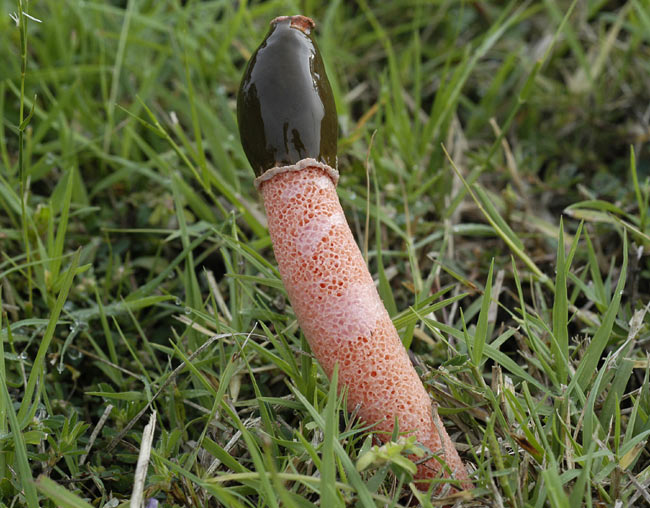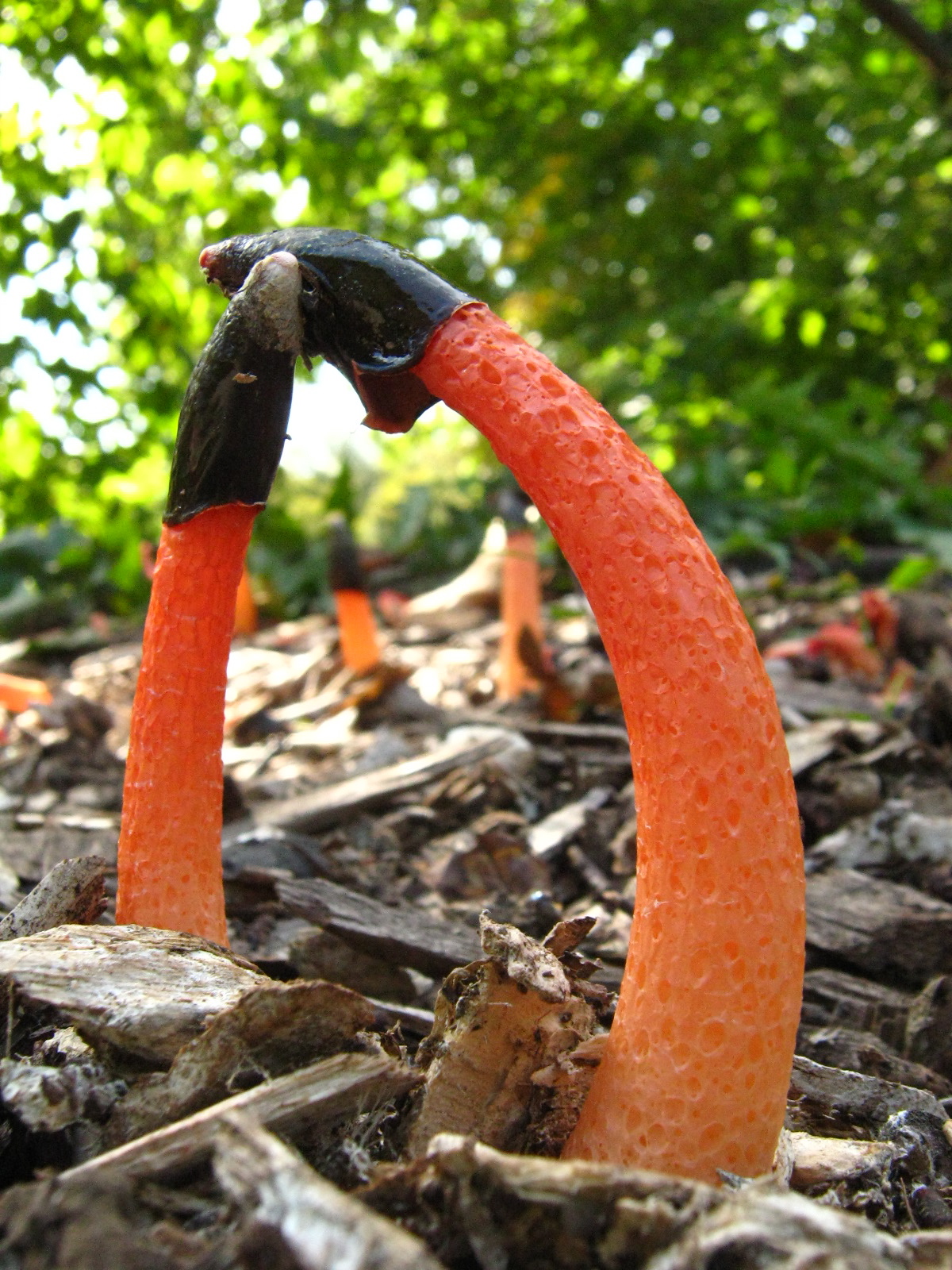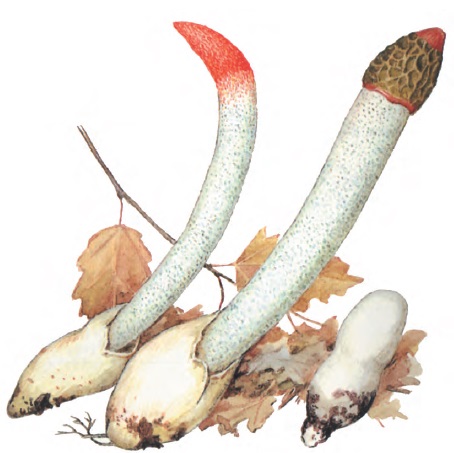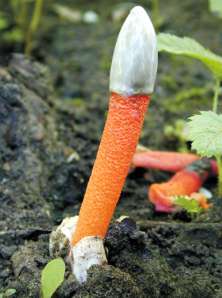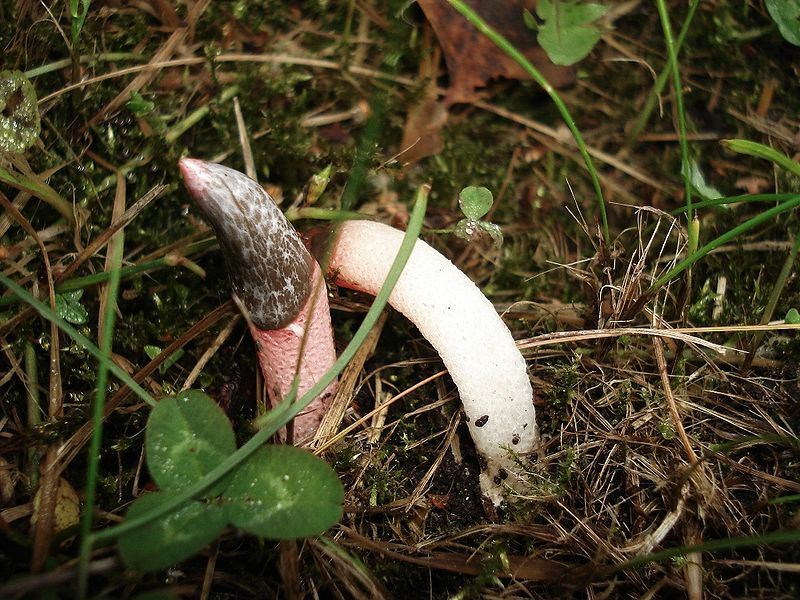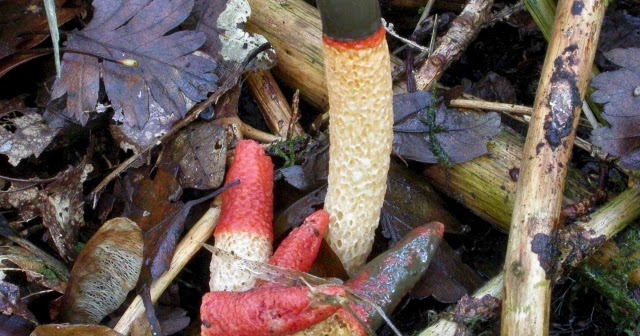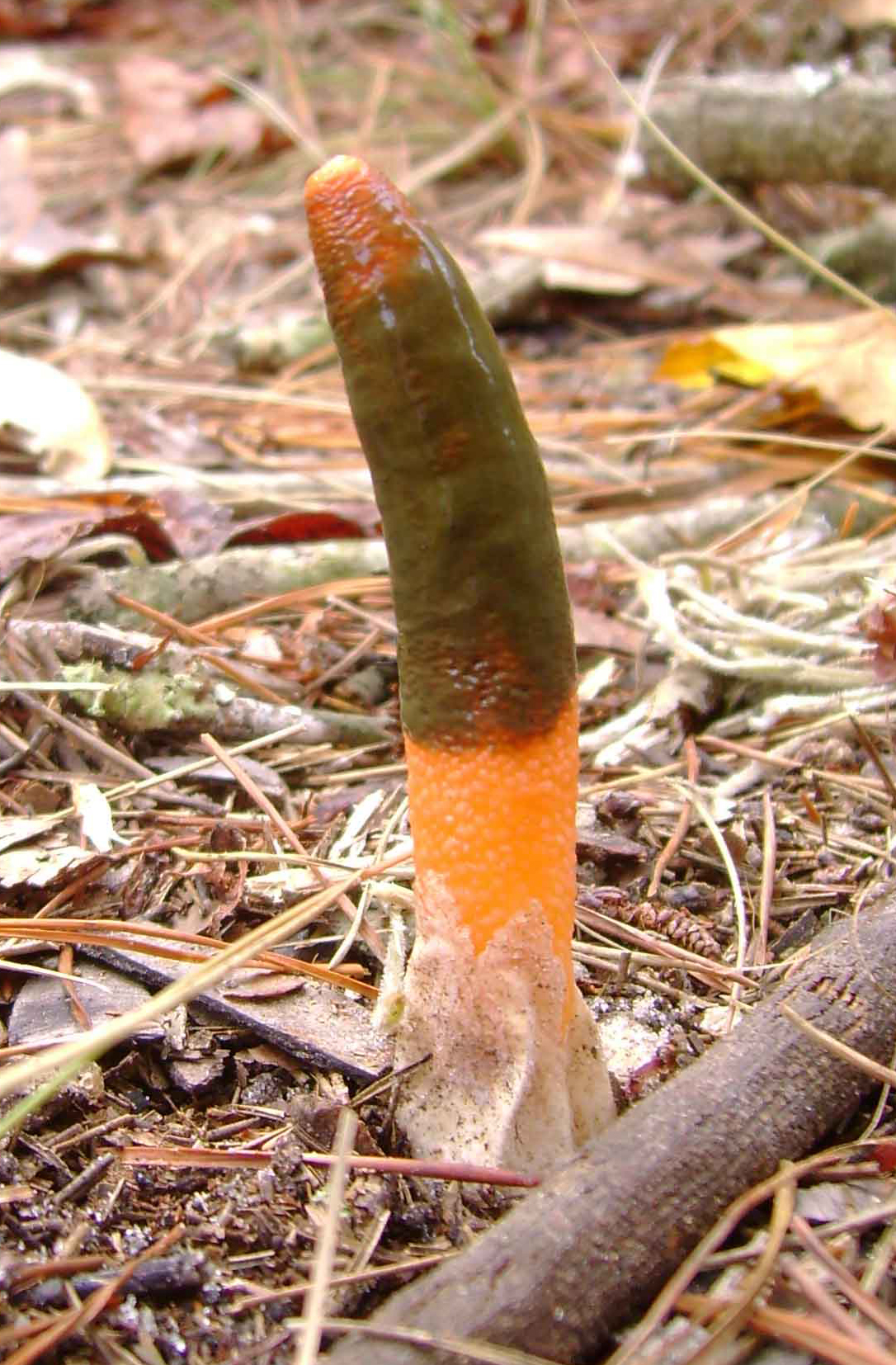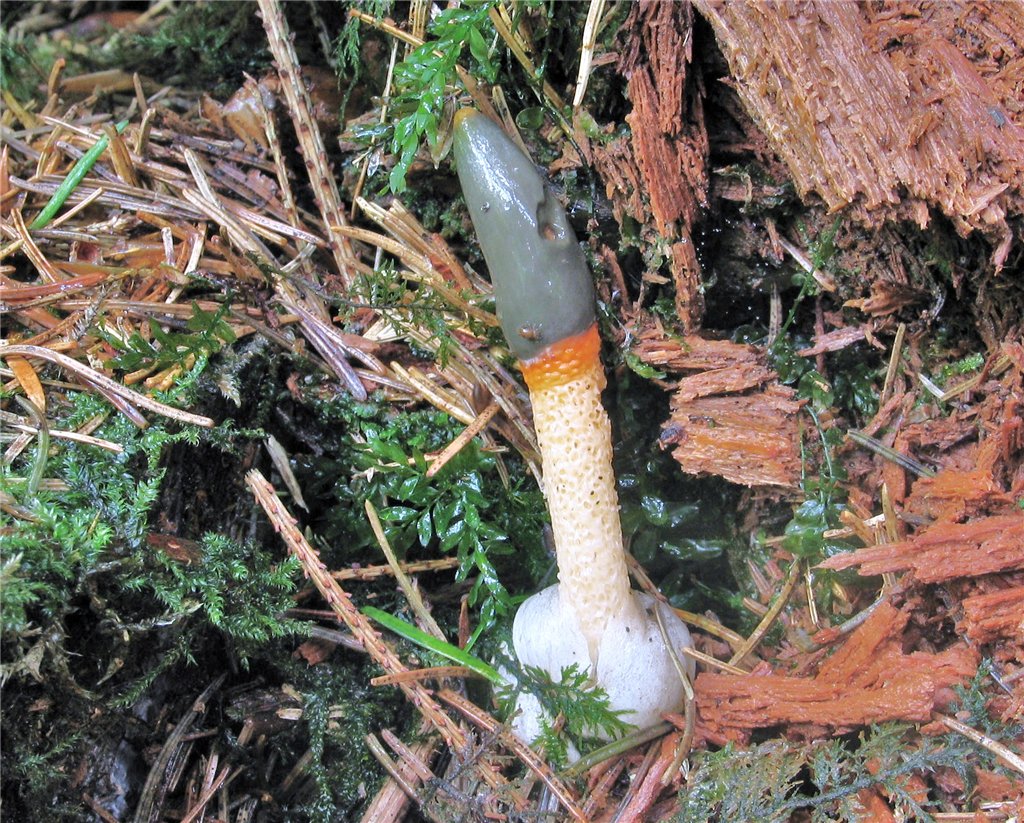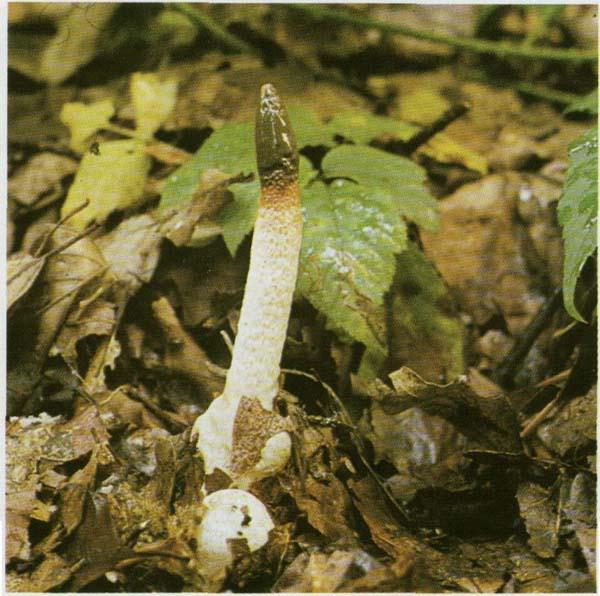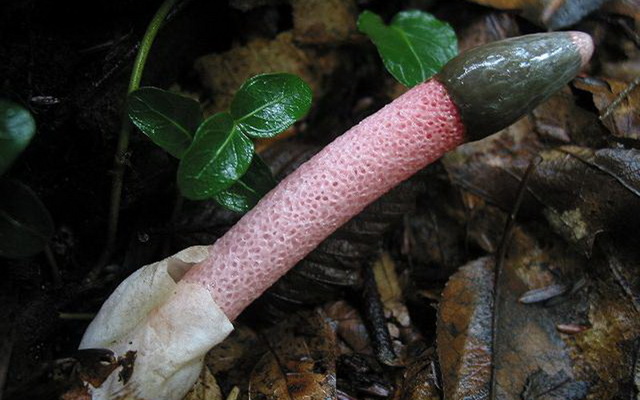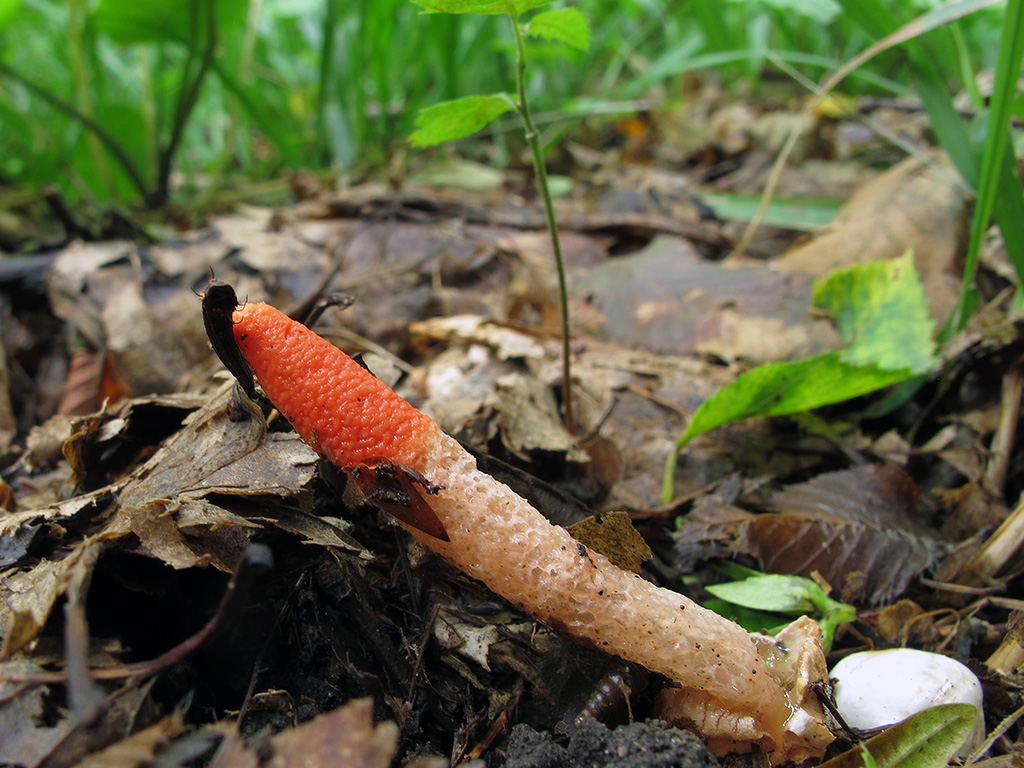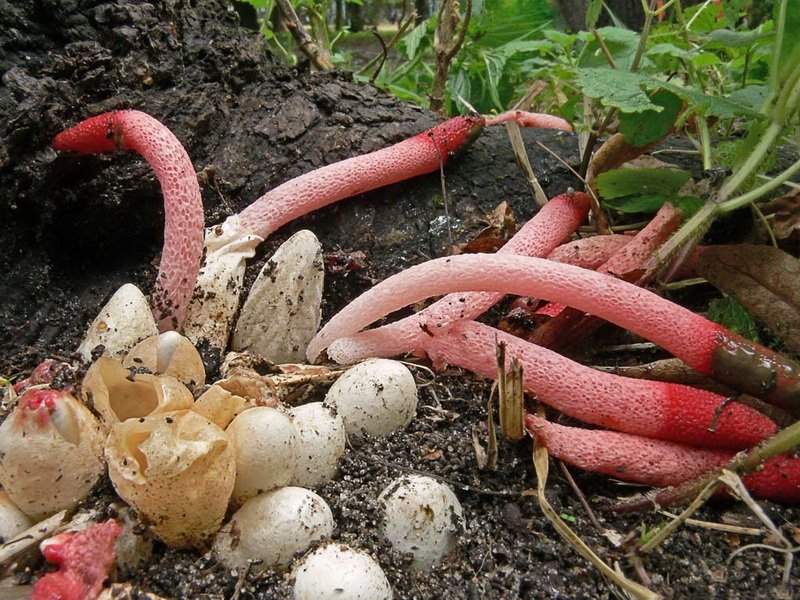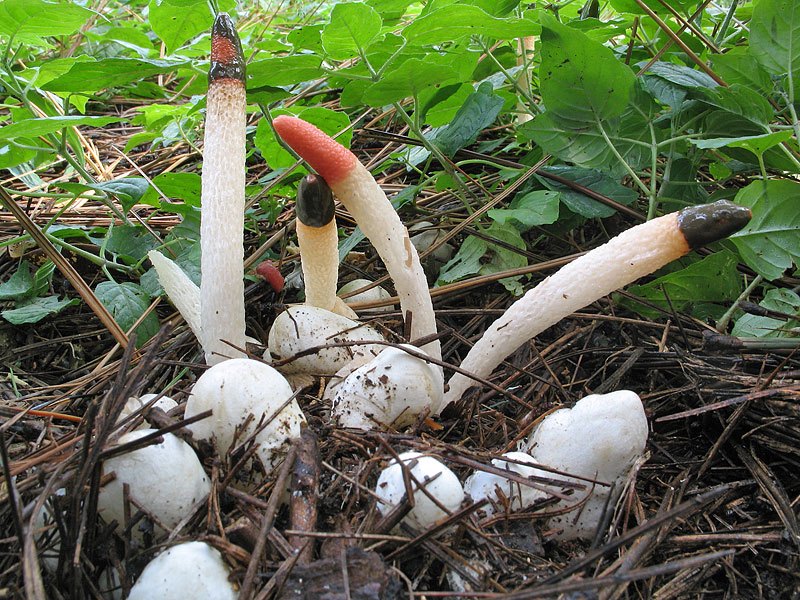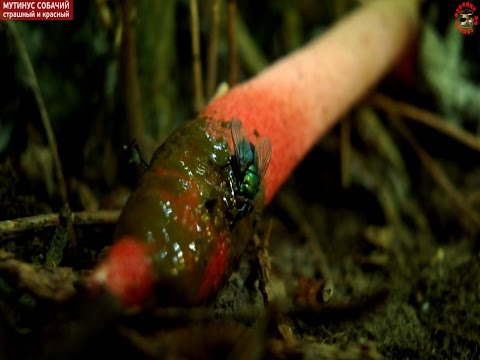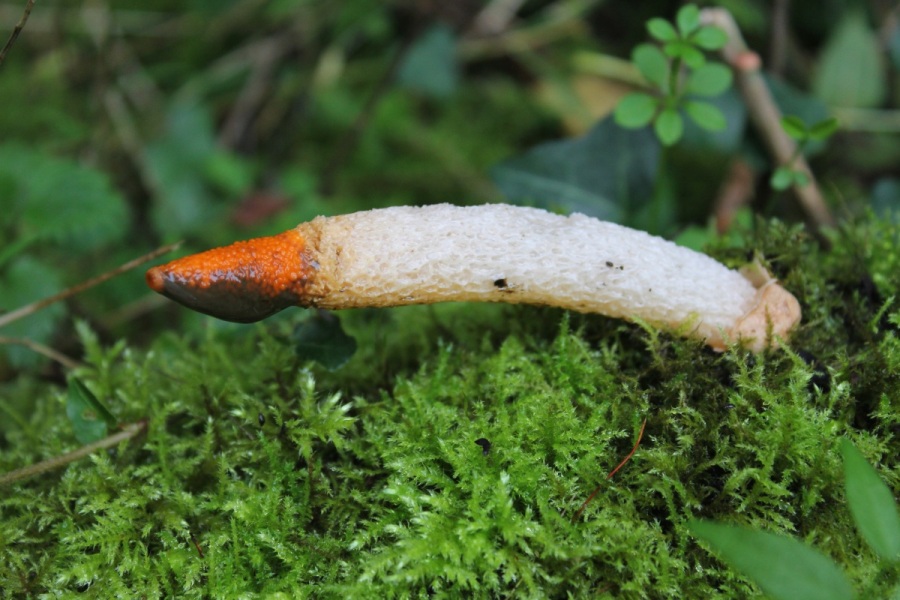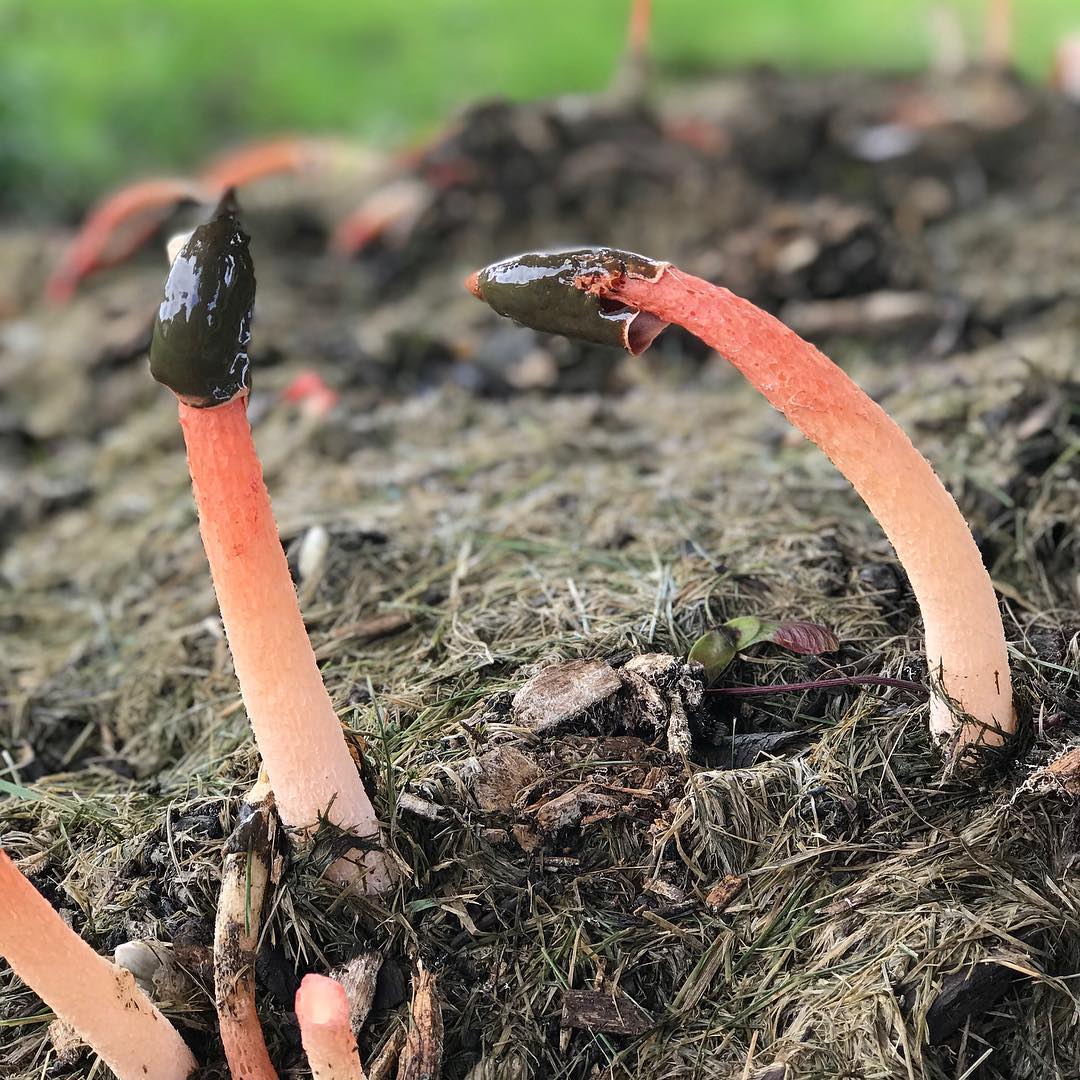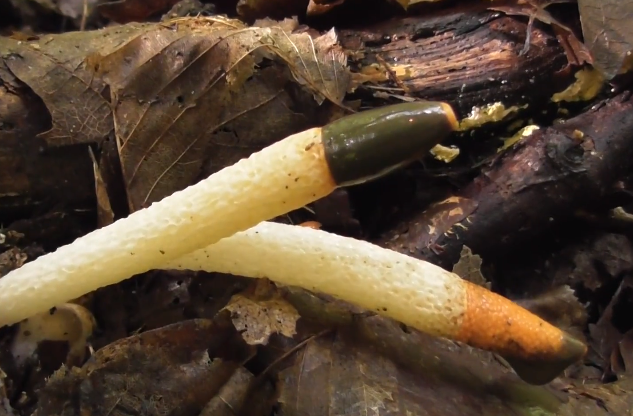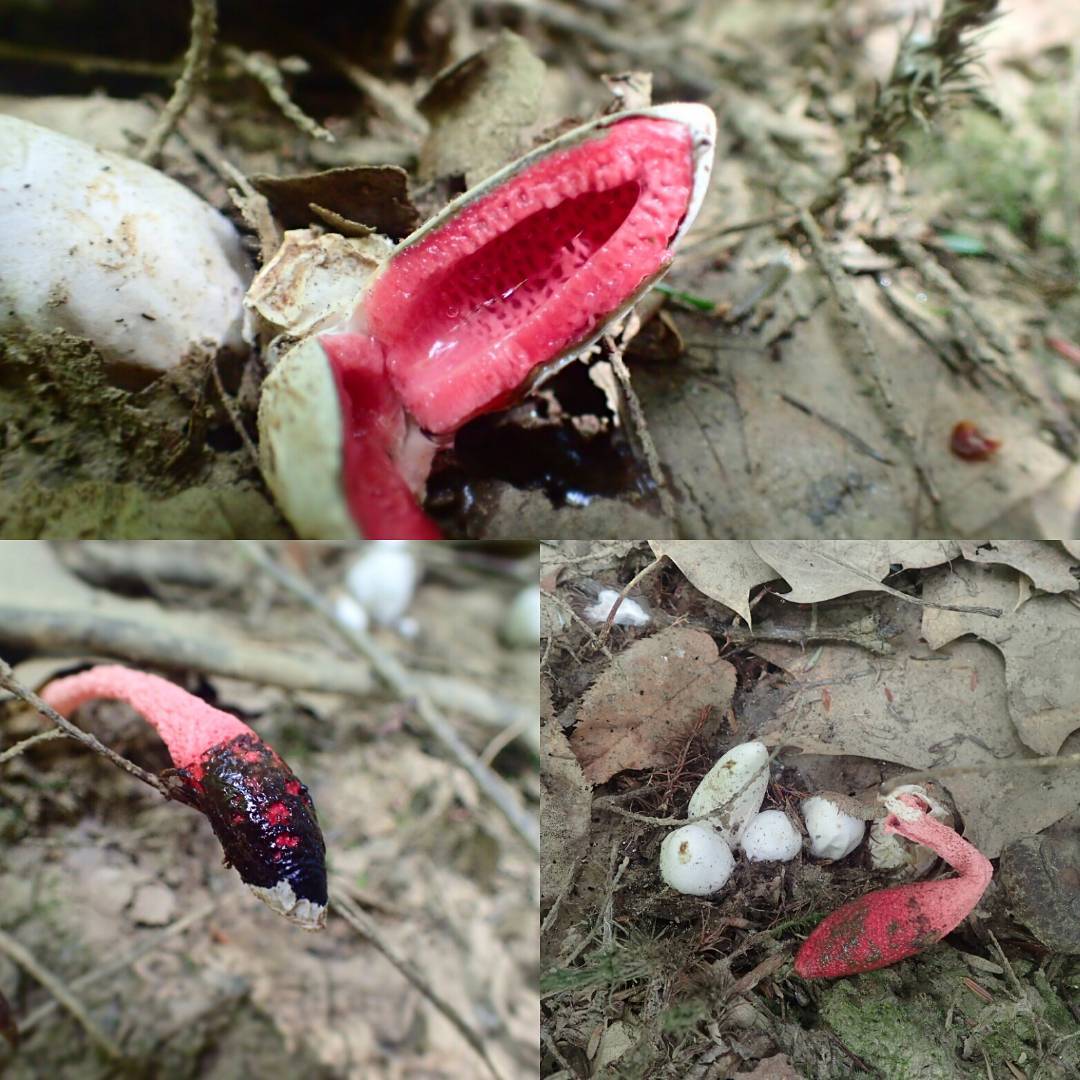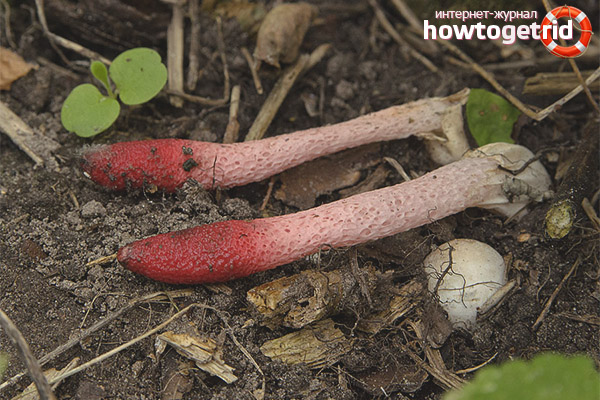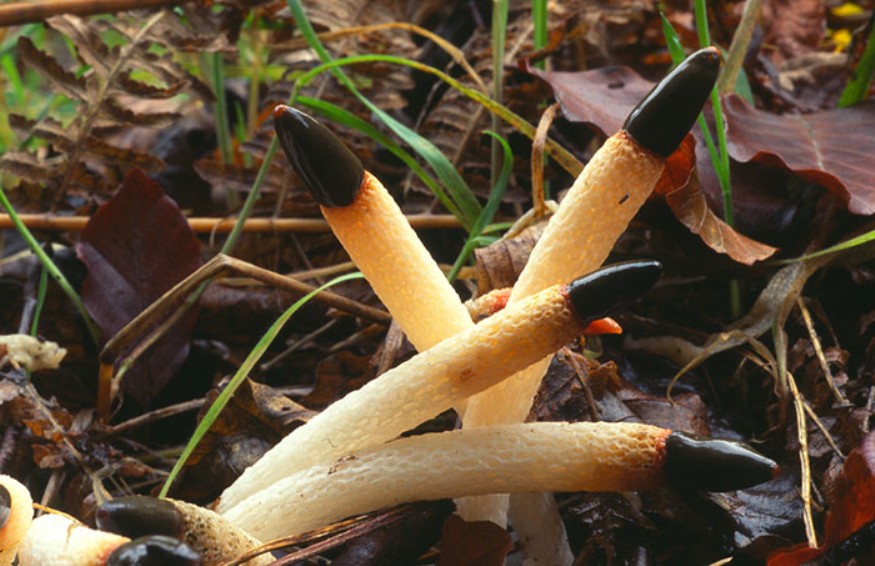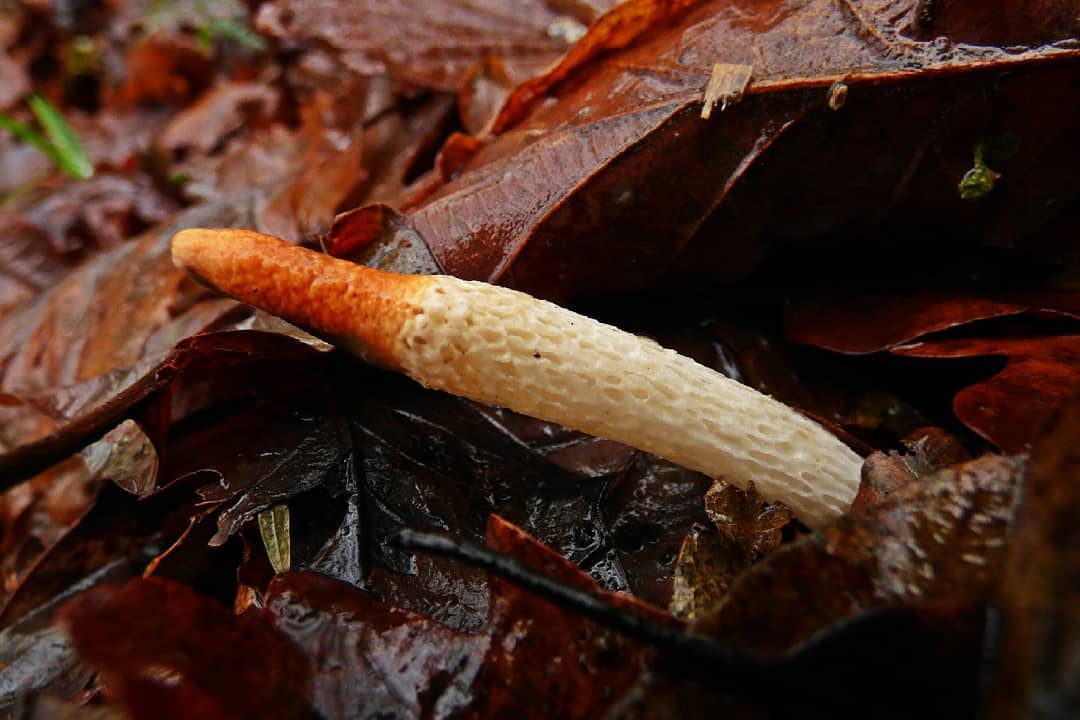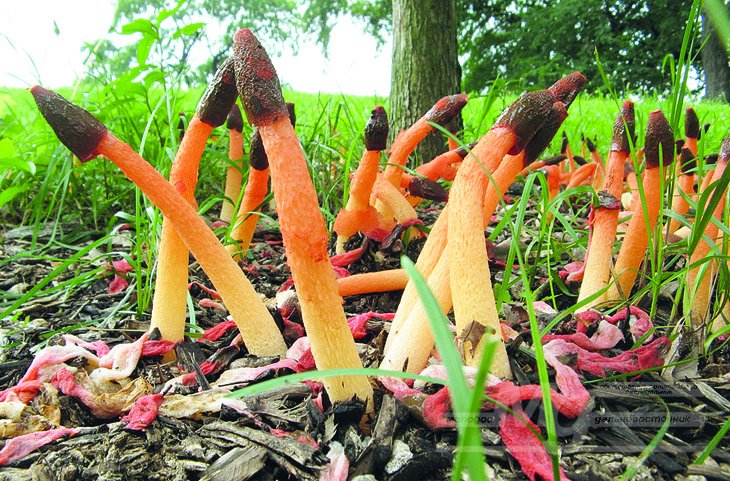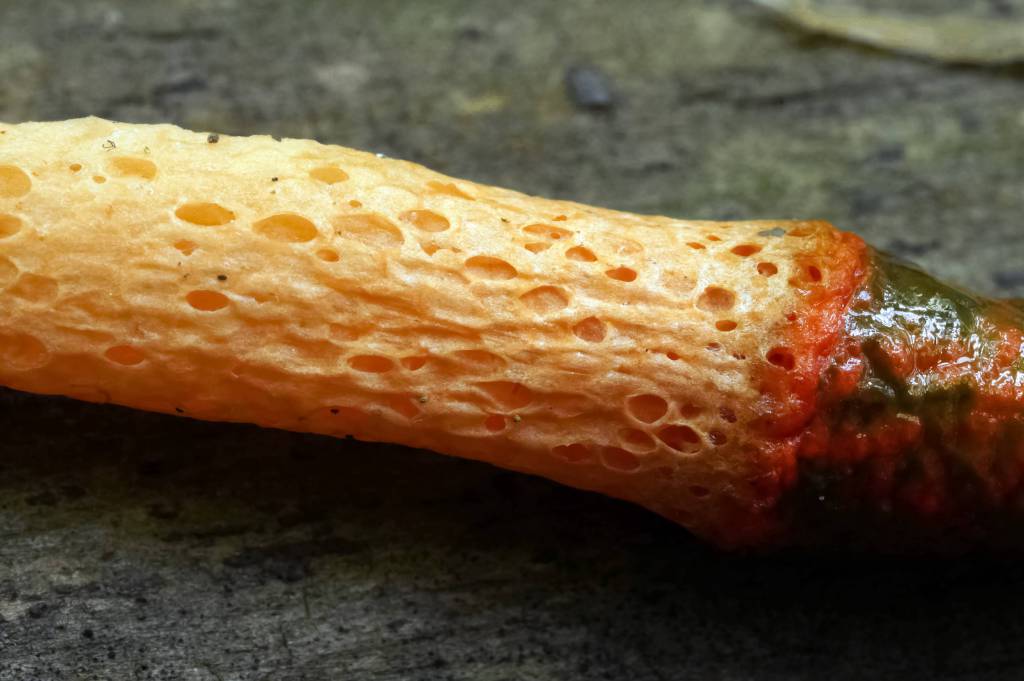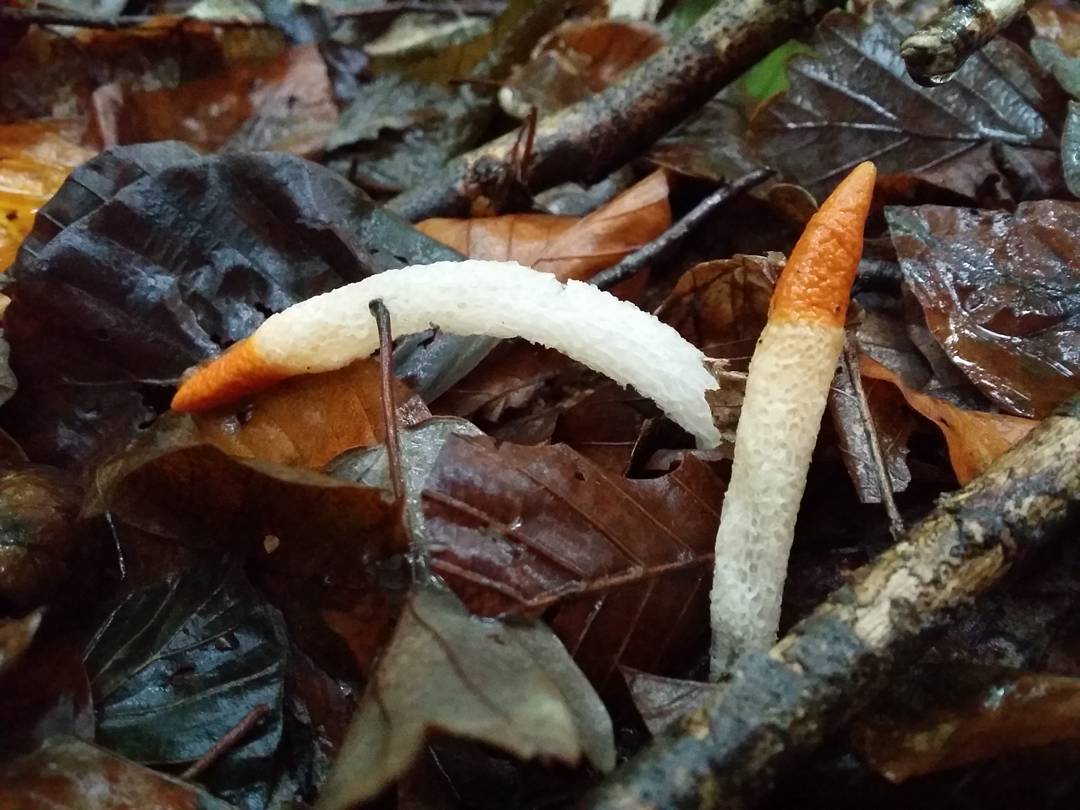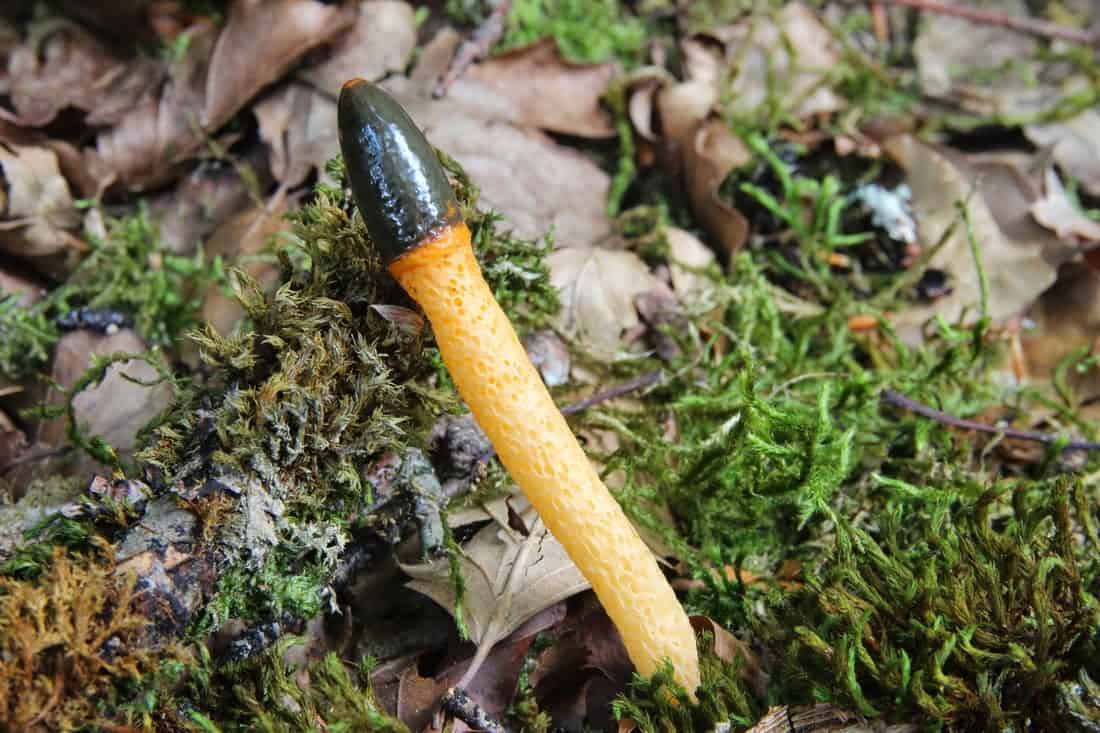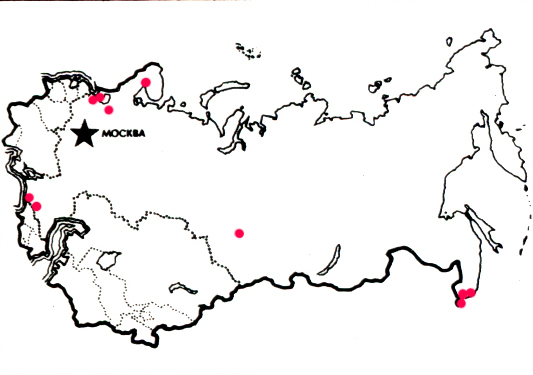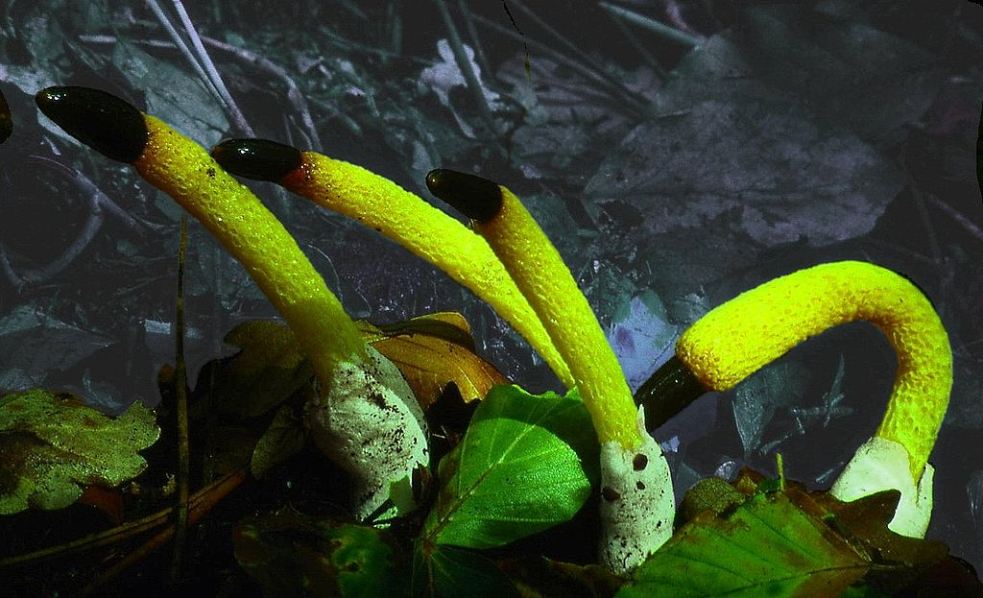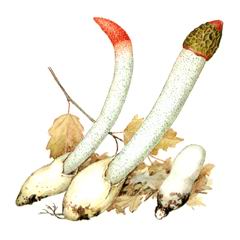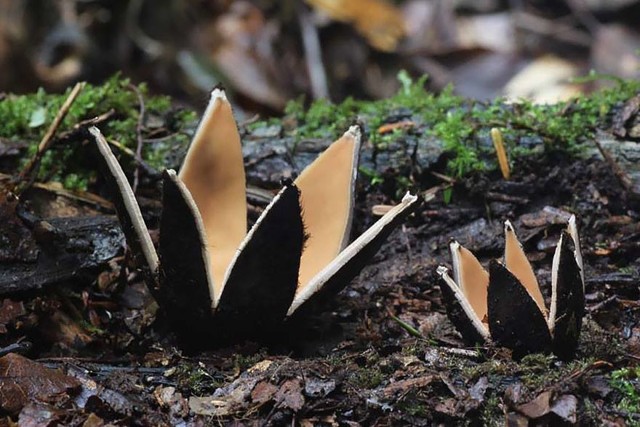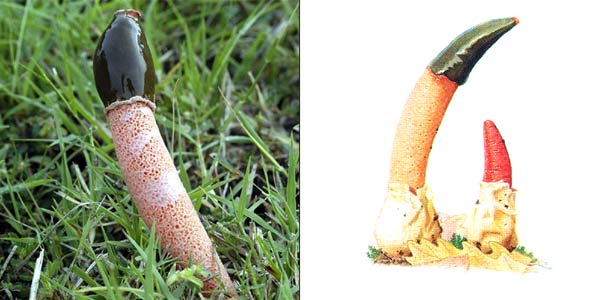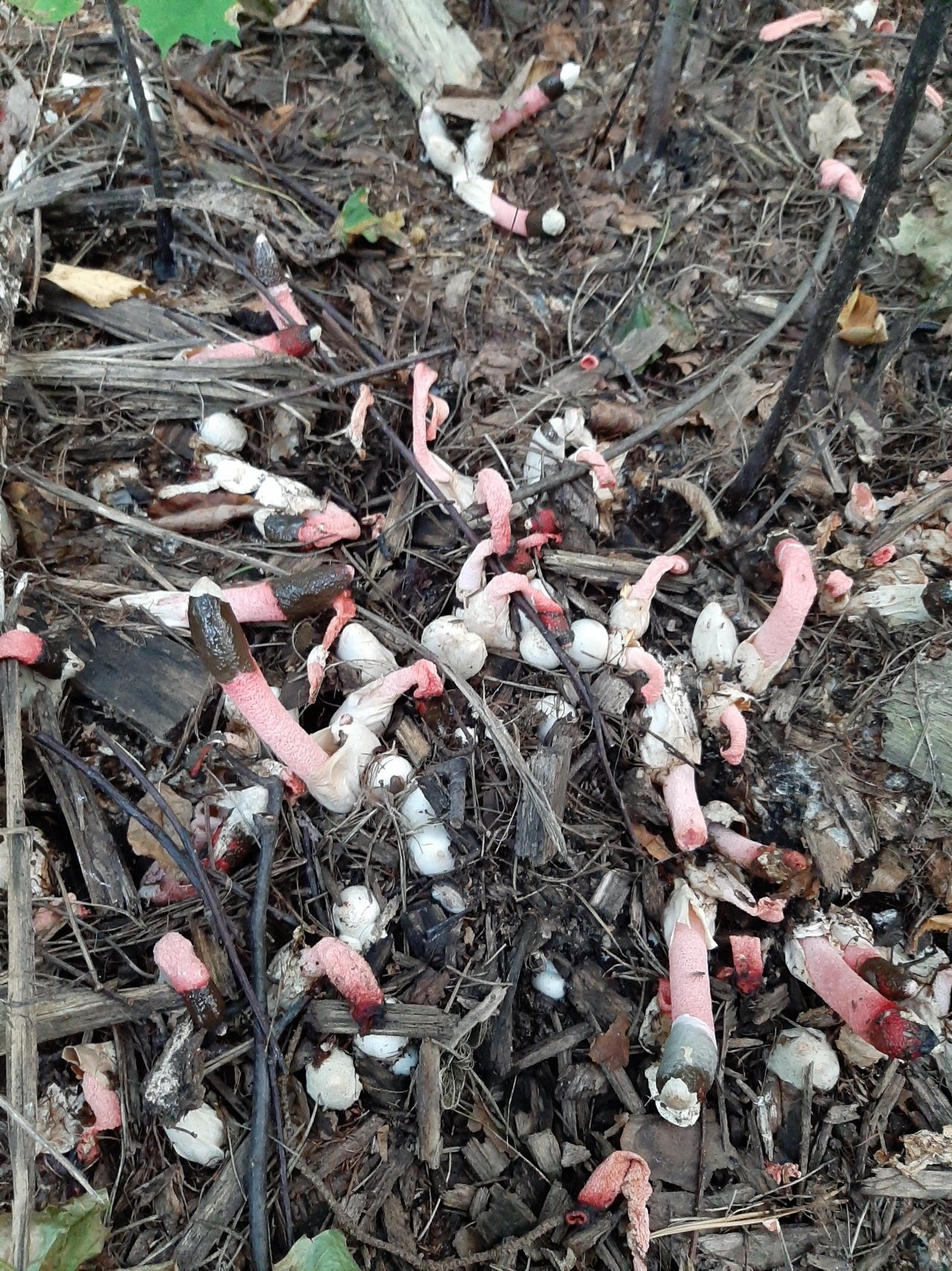Mutinus caninus or dog stench
Mutinus caninus, commonly known as the canine stinkhorn, or smelly horn, is a small, thin, phallus-like forest mushroom with a dark tip. It can often be found growing in small groups under fallen trees or in debris during summer or fall in Europe, Asia, and eastern North America. This mushroom is not generally considered edible, although there are reports of eating its immature forms (in the egg stage). (Pictures are clickable - click to enlarge)

Synonyms / Synonyms Phallus caninus Huds. (1778) Phallus inodorus Sowerby (1801) Ithyphallus inodorus Gray (1821) Aedycia canina (Huds.) Kuntze (1898) Cynophallus caninus (Huds.) Fr. (1860)
False doubles
You should not be afraid of the canine mutinus doubles, because they are also inedible, like this mushroom. The main copy is the Ravenel mutinus, which is distinguished by a more colorful body and white shells of eggs of a young fruiting body. Both varieties are considered edible during the immature, unhatched mushroom stage, but after the appearance of the recipe, they become inedible.
In addition, both species are rare, are listed in the Red Data Books of different regions of Russia, and therefore it is not recommended to eat, trample or pluck them.
Pay attention to the photo
Despite the fact that the mushroom is listed in the Red Book, some gourmets, having found it in the forest, will certainly try to cook and taste it. In this case, you should be especially careful, because it can be confused with a very dangerous and poisonous pale toadstool.
| Name | Appearance | Sectional view | Virulence |
Canine mutinus |
White egg with a firm surface | Below the surface, the structure of the egg is visible, there is a gray jelly, then a small part of the spores of a dark gray-green color and a fruit body, consisting of half of white and pink | Inedible |
Common fun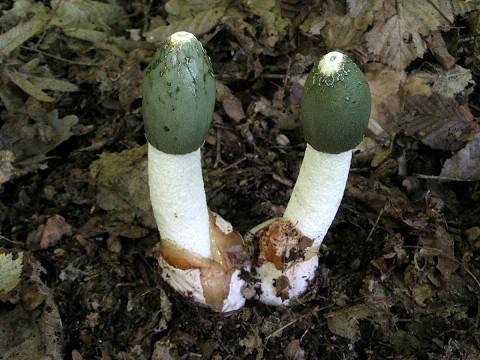 |
The surface of the egg has a beige tint, yellowish | Under the protective layer of jelly there is a spore-bearing khaki-colored mucus, in the middle is a white body | Inedible |
Death cap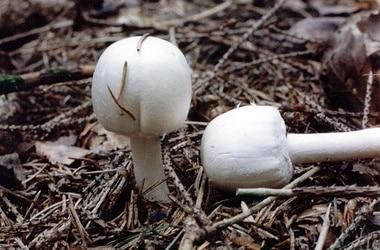 |
White egg covered with film | The egg content is completely white, the hatching is visible | Deadly, highly poisonous |
Anturus Archera |
The egg is gray, with a greenish tint | Layering is visible, a jelly-like shell is visible under the peridium, then a red body and spore-bearing olive mucus in the center | Inedible |
The use of mushroom eggs for food is very dangerous and not justified, such fruit bodies do not differ in special taste.
Dog mutinus: photo and description
| Name: | Canine mutinus |
| Latin name: | Mutinus caninus |
| Type of: | Inedible |
| Synonyms: | Cynophallus caninus, Ithyphallus inodorus, Phallus caninus |
| Specifications: |
|
| Systematics: |
|
Canine mutinus (Mutinus caninus) is an unusual species belonging to the Veselkovye family
The unique appearance of these saprobiotic mushrooms unwittingly attracts attention. However, the strongest repulsive smell of carrion will force the mushroom picker to refrain from collecting
Fungus growth stages
Mutinus caninus goes through several alternating developmental stages. In the beginning it is only a fruiting body. Inside it there is a gelatinous mass, in the very center of which a fruit "leg" is formed. The fruiting body itself at this stage has a diameter of up to three centimeters. It is light or slightly yellowish.
Then, as it grows, the top cover, which is called the peridium, is torn into several pieces. Usually two or three. These pieces fall to the bottom of the recipe. The recipe is a leg-like formation of light yellow or dull orange color. It is about 10-12 centimeters long and one centimeter in diameter.
Another feature of this representative is the smell of carrion, which exudes this mucus. This is what attracts insects, which carry the spores of the fungus on their paws and abdomen. After pollination and transmission of spores, the fungus no longer makes sense to exist, so the destruction of the fruiting body begins.At the same time, the top of the mushroom changes color to a bright orange. The fully fruiting body of the canine mutin disappears after three to four days.
It grows more often one at a time, less often you can find a group arrangement. This mushroom loves to live in humid places, it can often be seen in rotting wood or humus soils. The period from the last decade of June to October is the period of ripening of fruit chalk.
The mushroom is not very common in our country. Many mushroom pickers have never heard of him at all. However, it can be found in the forest belt of many countries in Europe and North America. About thirty years ago, a well-known Riga institute tried to create a special map of the prevalence of mutinus in the union of Soviet socialist republics. Unfortunately, this work did not take place, and today we cannot specify the exact places where this mushroom grows.
The fungus is fairly widespread in North America and Europe. Prefers coniferous forests, where it grows in small groups on stumps, fallen trees, sawdust or on the ground.
The fruiting period is early summer - mid autumn.
Mutinus Ravenel
The mushroom is not very common in our country. Many mushroom pickers have never heard of him at all. However, it can be found in the forest belt of many countries in Europe and North America. About thirty years ago, a well-known Riga institute tried to create a special map of the prevalence of mutinus in the union of Soviet socialist republics. Unfortunately, this work did not take place, and today we cannot specify the exact places where this mushroom grows.
The healing properties of mutinus and contraindications
- tannins:
- alkaloids;
- glycosides.
It is these substances that saturate the body with energy and protect against pathogenic bacteria. In addition, the mushroom can be used for medicinal purposes. So, to relieve the symptoms of an autoimmune disease of gout, which is practically not amenable to treatment, an infusion of mutinus will help. To do this, a handful of mushrooms are poured with vodka or alcohol, after which it is infused for 2-3 days in a cold room, deprived of direct sunlight. The resulting product is used to wipe the area of diseased joints several times a day.

Mutinus has powerful antioxidant properties, which allows a person to feel a surge of energy and strength. Unfortunately, many records regarding the beneficial properties of this mushroom have not been preserved to our time. It is only known that in ancient times canine mutinus was used to rejuvenate and prolong life.
Do not forget that with improper heat treatment, you can get poisoned with mutinus. In case of poisoning, the following are observed:
- headache;
- weakness;
- temperature increase;
- coldness of the extremities.
Remember, at the first symptoms you need to call an ambulance. Of course, a small portion will not cause such complications, however, if you eat dishes with these mushrooms periodically, the toxins will accumulate and gradually your health will worsen.
Medicinal properties and contraindications
You may be interested in: What is the difference between edible talkers and false mushrooms How many days after the rain mushrooms grow Bitter mushroom: photo and detailed description
Despite its inedibility, this mushroom is not completely useless. It has certain medicinal properties that are successfully used in traditional medicine. So, according to the healers, with the help of smelly morel-based means, you can fight:
- oncology of any severity;
- ulcers on the skin;
- diseases of the digestive system;
- renal and hepatic pathologies;
- joint diseases, including gouty arthritis;
- polyarthritis;
- paralysis;
- adenoma of the prostate gland;
- violations of potency;
- benign tumors of the uterus and mammary glands;
- hypertension.
Important!
The only medicinal activity of the fungus, which has been confirmed in the course of laboratory studies, is antitumor.The mutinus contains phytoncides, polysaccharides, phenols and sterols, which help to stop the growth of cancer cells, and can also lead to their regression and decay.
Among other things, natural phytoncides in the composition of the fungus effectively fight herpes, viral hepatitis and various strains of influenza. Therefore, mutinus ravelya can be called not only a natural antibiotic and antiseptic, but also a natural antiviral agent.
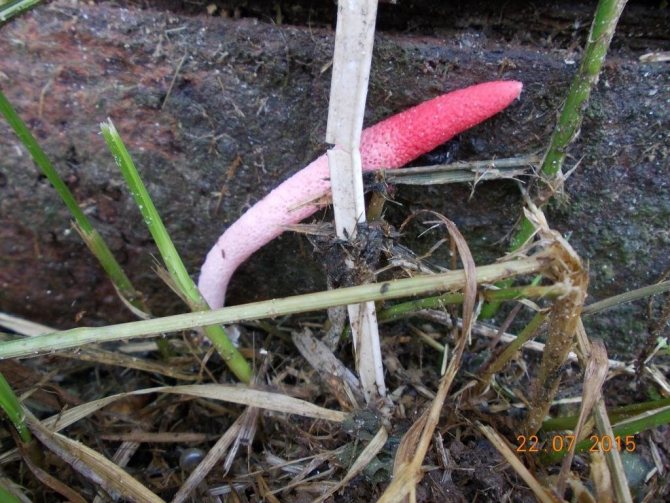
Contraindications
Veselka smelly has a lot of contraindications for use, since the mushroom is inedible, and in case of an overdose, even toxic. It is strictly forbidden to use it for food. As for the use in traditional medicine, it is contraindicated:
- persons with hypersensitivity to any components of the fungus;
- pregnant women;
- nursing mothers;
- children under 14 years old.
With caution, homemade preparations based on this fruit are prescribed to elderly patients. In any case, before using such a medicine, you should consult your doctor.
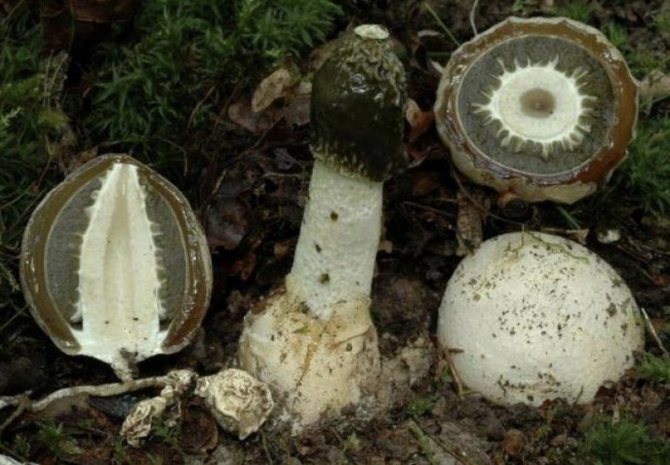
Mutinus Ravenel mushroom: photo and description
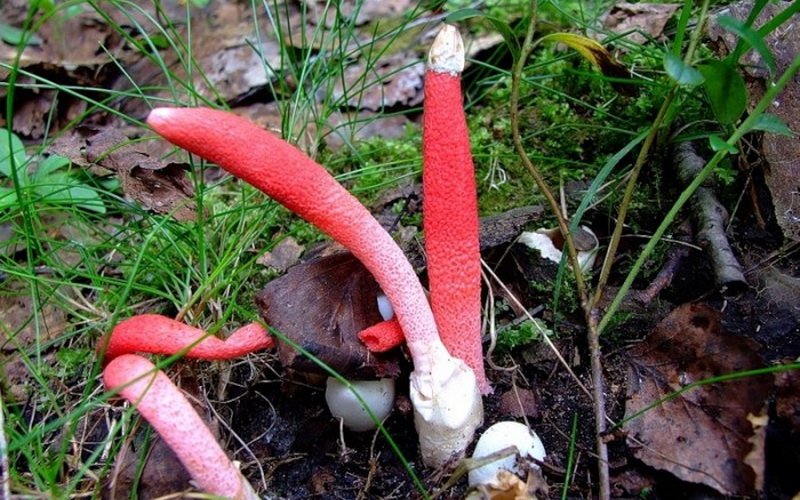
In the photo, the mushroom mutinus Ravenel
Outwardly, this variety of mutinus has a similarity to the dog. You can meet him in the forest from the end of July until September. Most often it can be found:
- on soils rich in humus;
- in places of decaying wood.
It grows especially quickly after heavy rains.
Outwardly, it looks very strange and not attractive. With all his appearance, he seems to show that he is inedible. In addition, it emits a rather nasty smell. It is for this peculiarity that the people received the name "smelly morel".
See what the Ravenel mutinus looks like in the photo:
In the process of its growth, the fungus goes through two stages of development, like the canine mutinus. Initially, an egg-like formation appears above the ground. Its size is rarely more than 3 cm in diameter. A delicate film formation hides the rudiment of the leg of the body, it looks like a bright red process.
The egg has two lobes that break and allow the porous stem of the body to develop. Its length reaches 9 cm, and in diameter it is no more than 1 cm. Towards the end, the stem has a red pointed tip. In an adult fungus, the upper part is covered with mucus with spores, which has a dark olive tint and gives off the smell of carrion. It is during this period that flies begin to circle near the mushroom, which are attracted by this stench. Its pulp is tender and porous.
If you find a mutinus in the forest, then examine it carefully. Despite all its unpleasant appearance, the mushroom looks very extraordinary. Do not rip it off, as this species is quite rare in our area. Perhaps you will not see another such specimen for a long time.
Saprobiotic species of Basidiomycete fungi - this is how Canine Mutinus is characterized
Its unusual appearance will certainly attract the attention of a lover of quiet hunting, but you should refrain from collecting and eating this species, although the smell of mutinus will do everything by itself
Description of canine mutinus
This representative belongs to the Veselkovye family, is a saprobiot and a basidomycete, which means the germination of spores in a special place - basidia
Mutinus will attract the attention of any mushroom picker, but you should not pluck it, since the fruit is inedible. It cannot be eaten for the reason that during the growth process it accumulates toxins and salts of heavy metals, which can harm the human body.
At the moment, the mushroom is listed in the Red Book of the Russian Federation.
What does a mushroom look like
At the beginning of its development, the mushroom resembles an egg with a diameter of 2-3 cm. The fruit body is yellowish with a root process. In the process of growth, it goes through 2 stages:
- immature or egg stage (when it is not life threatening);
- mature or stage of the recipe (the period of inedibility of the mushroom).
Immature mutinuses are ovoid, covered with peridium, smooth from above, and wrinkled downward. The mycelium branches off from the bottom. The sizes do not exceed 3 cm. The color of the mushroom is either white or with a pinkish tinge.As the peridium grows, it breaks and a mature fruiting body is formed.
A mature mushroom does not have a cap, and the remains of a gleba are located at the top (the inner part of the egg). The latter is controversial. The fruit body is porous and tender, with a reddish tint. The top is pointed, greenish in color and emits a putrid odor to attract flies, which will subsequently spread the spores. The spore powder is fine and colorless, has a smooth surface.
The structure and features of the species
After the fruiting body breaks out of the egg, 2-3 petals are formed at the base. The top of the mushroom is covered with brownish mucus, which gives off a rotten smell. The recipe itself can be up to 15 cm in length. Its inner part is hollow, and the walls have a spongy structure and some roughness. After the insects have collected all the spores, the fungus is destroyed. Its top turns bright orange. Destruction occurs within 3-4 days.
Description of canine mutinus
At the initial stage of development, the fruiting body of the canine mutin is oval or ovoid. Its diameter does not exceed 2-3 centimeters. The color of the fruiting body is yellowish. There is a root process.
When the canine mutinus ripens, the skin of the egg breaks open and 2-3 petals are formed. These petals remain at the base of the stem. At the second stage, a spongy hollow leg emerges from the opened egg. Its height is 5-10 centimeters, and sometimes it reaches 15 centimeters, its diameter is about 1 centimeter. The leg has a finely knobby thin pointed tip. The stem is light, yellowish in color, and its tip is red-orange.
When the mushroom is ripe, its tip is covered with a layer of brownish-olive mucus. This mucus is spore-bearing. The fungus emits a strong unpleasant smell of carrion, it attracts insects, most of all flies, which carry spores on their paws to new habitats. The spore powder is colorless. The pulp of the mushroom is very tender, porous.
Areas of growth of canine mutinus
Canine mutinuses bear fruit from late June to September. They grow in deciduous forests. They prefer to settle in humus-rich soil. You can find these mushrooms among rotting wood, in bushes, in damp places.
Canine mutinuses are rarely seen. They grow in the same places.
Can dog mutinus be eaten?
Canine mutinuses are inedible mushrooms, but as long as the fruiting bodies are in the egg shell, they can be eaten.
Other fungi of this genus
Canine mutinus bears similarities to other rare mushrooms - Mutinus Ravenelli or smelly morel. This is also an inedible mushroom.
The fruit body of the canine mutinus first looks like a pointed egg, the diameter of which is 2-3 centimeters, yellowish. This egg contains a bright, red-pink primordium. The egg breaks in half, and a porous leg emerges from it, hollow inside, 5-10 centimeters long and 1 centimeter in diameter. The color of the leg is pink, and the tip is red-crimson. When the mushroom is ripe, the tip is covered with a thick brown-olive slime. Mutinus Ravenelli, like the dog mutinus, emits a pungent smell of carrion.
Mutinuses Ravenelli bear fruit from June to September. They grow in deciduous forests and gardens. Choose soils rich in humus. You can find them in bushes and near rotting trees. They grow in groups, appearing after rains. They are rare.
Mushrooms of the genus Mutinus: Ravenel and canine
Mutinus ravinelii is inedible when grown up. The fruit body of the mutinus mushroom is a hollow stem tapering upward, up to 8-12 cm long, 1-2 cm thick. The surface of the leg is first white with pink dots, then pink fine-mesh. The upper part of the leg ends with a red head, which is later covered with a thick layer of spore-bearing mucus of olive or marsh green color with the smell of carrion. The lower part of the leg is in the remains of the egg from which the fruiting body has grown. The egg is attached to a white tapered strand of mycelium. The fruit body grows from a 1.5 x 2 cm egg, which is considered edible.
Grows in deciduous forests, parks or gardens under aspen or hazel. The fungus is not mycorrhizal, but, according to experts, it supplies plants with water, storing it in the rain in its mycelium.
Occurs from July to September. Rare view.
The main features of the genus Mutinus
In the photo Mutinus ravinelii
Ravenel's mutinus (Mutinus ravinelii) is confused with the canine mutinus (Mutinus caninus), which has a yellow-beige leg.
He came to Western Europe in the middle of the last century from America. But on the territory of Russia you will not meet him so often. Loves fertile soil, grows actively at high humidity.
The main features of the development and structure:
- in the development process, there are two stages (ovoid and the appearance of a cylindrical leg);
- the body of the mutinus is spongy, porous;
- the stem ends with a tip that differs in color (usually brighter);
- it multiplies, like all mushrooms, by spores that are contained in the formed mucus with an unpleasant, putrid odor;
- the spread of spores occurs with the help of insects.

- in the development process, there are two stages (ovoid and the appearance of a cylindrical leg);
- the body of the mutinus is spongy, porous;
- the stem ends with a tip that differs in color (usually brighter);
- it multiplies, like all mushrooms, by spores that are contained in the formed mucus with an unpleasant, putrid odor;
- the spread of spores occurs with the help of insects.
The kingdom of mushrooms occupies a separate place in biological science. There are more than 250 thousand of them. Mushrooms can live both on land and in water, with different readings of humidity and temperature.
Some species may outwardly be similar to each other, or they may be completely different, for example, the genus Mutinus, which has a very extraordinary appearance, bears little resemblance to a mushroom in the minds of most people.
They are considered quite rare.
Taxonomy of Mutinus caninus
The name of the genus came from the name of the phallic deity - Mutinus, known to the Greeks as Priapus (Priapus - in ancient mythology, the ancient Greek god of fertility, fields and gardens among the Romans. Depicted with an overdeveloped penis in a state of eternal erection); one of the Roman indigits, "indigenous Gods", pacified by Roman brides. Caninus is Latin for "dog". Mutinus is a diminutive of muto, Latin for Penis. Mutinus was originally described by William Hudson (1730-1793), a renowned British botanist. Its common French names such as Phallus de Chien, Satyre des chiens also hint at its resemblance to a dog's penis. Mutinus Caninus is commonly known as the "dog smelly horn".
Description of the mushroom:
This small member of the Phallaceae family emerges from an off-white, egg-shaped, fertile body that lies half drowned in a leafy bed among the trees. White filamentous cords (rhizomorphs; filaments) are often visible beneath this "egg", which is 2-4 cm (1-1.5 inches) high and 1-2 cm (0.5-1 inches) wide. The egg has a tough outer shell (peridium) that covers a gelatinous inner layer, which in turn protects the fully formed but undiscovered fruiting body. When the egg breaks down into petals, the mushroom grows rapidly (usually within a few hours), reaching a height of 10-12 cm (4-4.5 inches). A ripe mushroom is about 1 cm (0.5 in) in diameter and is yellowish white, yellow, or pale orange in color.
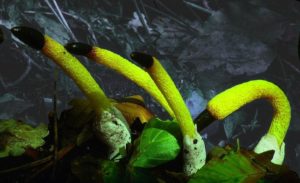
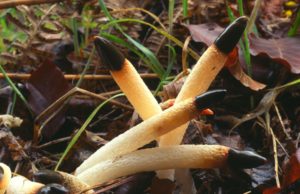
Mutinus caninus Mutinus caninus var. albus
Similar species
Species from the genus Mutinus, similar to Mutinus canine. Mutinus ravenelii is pinker in color, with a red tip. It is a rarer American species that is now spreading in Europe. Another North American species, Mutinus elegans, is very similar to M. ravenelii, but is less long, stocky, with a more pronounced pointed tip.
Distribution and habitats of Mutinus Can.
Rarely, Mutinus Caninus is found in Europe, Britain and Eastern North America. Mushrooms are included in the red data list of Ukraine (Regional Red List, RRL, Red Book).The collection from the Canary Islands has been noted as the southernmost collection for species in the Northern Hemisphere. Dog stinkhorn has also been encountered in Iran, Turkey, China, including Hebei, Jilin and Guangdong provinces. It can be found from early summer to late autumn; usually grows in small groups in old fallen leaves, on wood remains, forest roadsides. Moreover, it can be found both in deciduous and coniferous forests. The fruiting bodies of the fungus M. caninus can serve as a food source for Solenopsis molesta (fat ants, thief ants - got their nickname from the habit of nesting next to other nests of ants from which they steal food) and the black fly fly (Phormia regina).
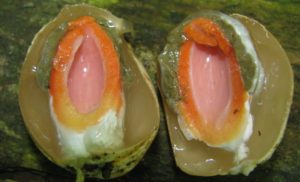
Mutinus ravenelii

Current title
Systematic position
Etymology of the species epithet
Ravenelii, in honor of Ravenel (Henry William Ravenel, 1814 - 1887, American mycologist).
Synonyms
- Corynites ravenelii Berk. & M.A. Curtis, Trans. Linn. Soc. London 21: 151 (1853)
- Ithyphallus ravenelii (Berk. & M. A. Curtis) E. Fisch., Jb. Königl. Bot. Gart. Berlin 4: 88 (1886)
- Dictyophora ravenelii (Berk. & M. A. Curtis) Burt, Bot. Gaz. 22: 385 (1896)
Habit
Fruit body: Rounded, star-shaped, merry, nested (gasteroid)
Hymenophore: Absent or difficult to classify
Fruiting body
Young fruiting bodies are closed, ovoid or oval, 2 - 3 cm in diameter, covered with a two-layer shell. The shell is white or slightly yellowish; when ripe, it breaks in the upper part and remains in the form of a bag at the base of the fruiting body.
The leg (recipe) is hollow inside, spongy-porous, pink, white-pink, bright crimson, 5-12 cm tall and 0.4-1 cm in diameter. Its top, in contrast to the fun, without a detachable cap, pointed, bright pink; over time, it becomes covered with an olive mucous mass containing spores, with a very strong, subjectively unpleasant, cadaverous odor with unexpectedly pronounced floral notes. Apparently, it is this combination of odors that best attracts flies, which actively carry the mass with the spores of the fungus on their paws.
Microscopy
Spores narrow ellipsoid 3 - 5.5 × 1.5 - 2.5 µm, almost colorless, smooth, spread by insects.
Ecology and distribution
Substrate: Soil, litter
It lives in deciduous forests, forest belts, old parks, on humus-rich soil, less often on buried wood, always in humid places. more and more abundantly every year; in another case, mutinuses met in the middle of a bus stop in the center of Berdsk.
Occurs sporadically, in small groups.
Fruiting
July - September.
The divisions correspond to the decades of the month.
Nutritional properties
Similar species
Mutinus canine (Mutinus caninus) - a leg, unlike M. ravenelii, with pronounced warm, golden-orange shades.
Conservation status
- Red Data Book of the Novosibirsk Region 2008. A rare species. It is necessary to search for new habitats of the species, their protection and monitoring. An introduction to culture in botanical gardens and arboretums.
- Red Data Book of the Novosibirsk Region 2018. Rare view. The search for new locations of the species is being carried out.
- Red Data Book of Altai Krai 2006. Rare species. It is necessary to control the state of known populations, search for new locations of the species.
Related materials
- Red Data Book of the Lipetsk Region. Volume 1. Plants, mushrooms, lichens. / Ed. V.S. Novikov. - M .: OOO "KMK", 2005. - 510 p. - S. 444.
- Red Data Book of the Novosibirsk Region: Animals, Plants and Mushrooms / Department of Natural Resources and Environmental Protection of the Novosibirsk Region. - 2nd edition, revised and enlarged. - Novosibirsk: "Arta", 2008. - 528 p. - S. 510.
- Red Book of the Altai Territory. Volume 1. Rare and endangered plant species. - Barnaul: OJSC IPP Altai, 2006. - 262 p. - S. 232.
- Berkeley M. J. On two new genera of fungi. // Transactions of the Linnaean Society of London. - 1852. - V. 21. - P. 149-154.
- Red Data Book of the Novosibirsk Region: Animals, Plants and Fungi / Ministry of Natural Resources and Ecology of the Novosibirsk Region. - 3rd ed. revised and enlarged. - Novosibirsk: Printing house of Andrey Khristolyubov, 2018 .-- 588 p. - S. 543.
Link to this page for prints
Canine mutinus is edible or not?
There are no poisons in the chemical composition of canine mutin, no cases of poisoning were recorded. The mushroom is considered inedible, however, some argue that it can be eaten during the egg stage. Of course, it is better to refrain from such experiments with your own body, and in the absence of other mushrooms, buy the same mushrooms in the store.
People are used to eating mushrooms. Can dog mutinus be eaten? Experts assure for sure that in the second stage, the "adult" fruit body is inedible and dangerous to eat. But there is no data on edibility at a young age. Perhaps someday there will be experimenters who want to test the hypothesis of the possibility of eating the young fruiting bodies of Mutinus caninus.
Contraindications to use are considered to be under 12 years of age, pregnancy and lactation, as well as diseases of the gastrointestinal tract, liver and kidneys. There were no medical fixations of poisoning with mutinus, no poisons were found in it, but it is not officially treated with it.
Virulence
They absorb many toxins, heavy metal salts and copper isotopes. The first symptoms of poisoning appear at different times. It depends on the individual characteristics of the organism.
Poisoning symptoms
Symptoms of poisoning appear 2-3 hours after eating the mutinus. First of all, weakness and indigestion are felt. Later, other symptoms appear:
- headache;
- lowering blood pressure;
- increased sweating;
- increased body temperature;
- cold extremities;
- inflammation of the stomach walls (pain in the stomach area).
If a large amount of a poisonous substance enters the body, the development of botulism is possible. Seek medical attention as soon as possible.
Such symptoms of poisoning do not appear every time. If a person has eaten a small portion of mushrooms, they may not be there at all. But toxins can accumulate in the body and cause a deterioration in well-being later. There is a risk of a rather large development of vein thrombosis in the body, anemia, as well as stroke, heart attack, and less often - pulmonary vein thrombosis.
Treatment for poisoning

The fungus can cause severe poisoning
When the first signs of poisoning appear, they immediately call an ambulance. Before the arrival of the doctor, it is worth rinsing the stomach. First they drink a lot of water, and then they induce vomiting. This is necessary to remove pieces of the fungus from the stomach so that a probe can be inserted in a hospital. It is also useful to take a large portion of sorbents: 1 tablet of activated angle per 1 kg of body weight. To normalize the patient's condition, it is necessary:
- take a laxative if the victim does not have diarrhea;
- drink plenty of fluids to flush out toxins;
- regularly check the patient's temperature.
Attention! It is forbidden to give alcohol to the victim, because it accelerates the absorption of toxic substances into the blood
Also, do not eat anything, take painkillers or antipyretics. Do not benefit from vomiting and diarrhea remedies.
After hospitalization, the patient's stomach is washed again, but a saline laxative is injected through a special tube and intravenously. Also, the patient is detoxified, it can be hemodialysis or enema. The choice of method depends on how much dangerous substance the patient has eaten. In severe cases, a drip is placed and antibiotic treatment is started.
It is important to stick to your diet for faster recovery. It includes:
- refusal from spicy, salty, fatty and smoked foods;
- a ban on drinking and smoking;
- boiled and steamed food is introduced into the menu;
- all products are finely chopped and chopped.
Please note! Violation of the diet during the recovery period is unacceptable.
Mutinus Ravenel
This mushroom is NOT EATABLE!
You can find this guest from America, once brought first to Europe, and then to our endless expanses, by the specific rotten smell with which this fun attracts flies.Suspecting that some mysterious creature suddenly died within the suburban area or somewhere nearby, the summer resident may find, instead of the mortal remains, a very entertaining mushroom colony.
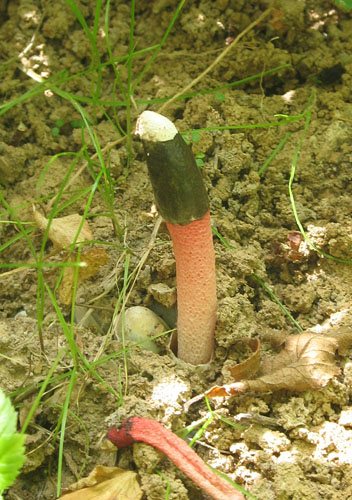
Pink-red tubular rods hatch from white eggs, on top of which a brownish-brown smelly mucus is wet. These are mushrooms called Ravenel's mutinus - Mutinus ravenelii. Domestic reference books awarded the same mushroom the name "smelly morel". The height of the tubular column is about 5-8 cm, in diameter it is 0.5-1 cm. According to my observations, on a clear day, the smell spreads to 3-4 meters, light gusts of breeze increase the spread of the smell by a few more meters. The scent is intense, overpowering the aromas of flowers and herbs.
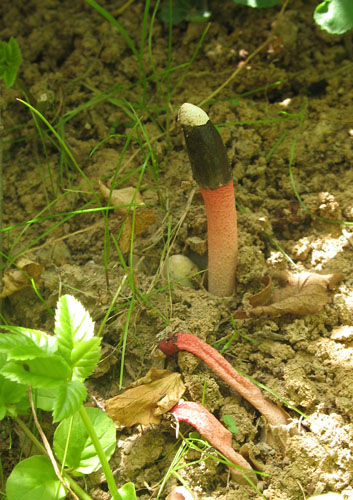
The essence of the life of stinkers is both simple and peculiar. The brown mucus is devoured by flies, collecting for the smell in fair quantities. Together with the treat, they receive a portion of mushroom spores, which are carried around the neighborhood and germinate in any suitable places. Grass and leaf litter with sufficient moisture are suitable.
The mutinus is rarely found, which is probably due to the inattention of mankind to what stinks underfoot, and the difficulty of survival of the mutinus in our climate, which is not too favorable for it. However, the mutinus successfully settled practically throughout the entire territory of Russia, which is very successful for a small mushroom.
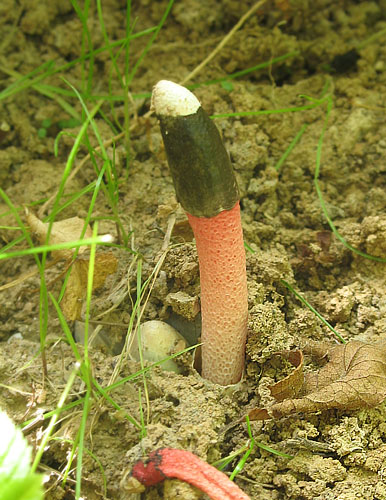
Mutinuses belong to the Veyolkovy family (Phallaceae), of which the most famous Veselka ordinary, which entered folklore due to its similarity with the anatomical feature of the male body. Mutinus Ravenel does not very much resemble the primary sexual characteristic, but it was his columnar shape that led me to the idea of where, in general, to look for information about what kind of dirty trick adorned my summer lawn.
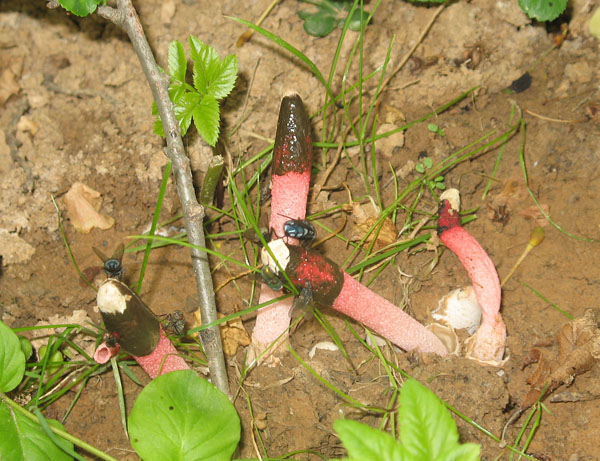
Wikipedia provides a bunch of Latin synonyms for mutinus - Corynites ravenelii, Ithyphallus ravenelii, Dictyophora ravenelii. Only the mention of Ravenel remains unchanged in them. The first attempt to find out who this Ravenel was, led me to another mushroom that bears the same name. The Ravenel's bullet gun (Pulveroboletus ravenelii) fascinated me with its name, and I even tried in vain to memorize it so that I could intelligently swear on occasion, comparing some opponent to a bullet gun.
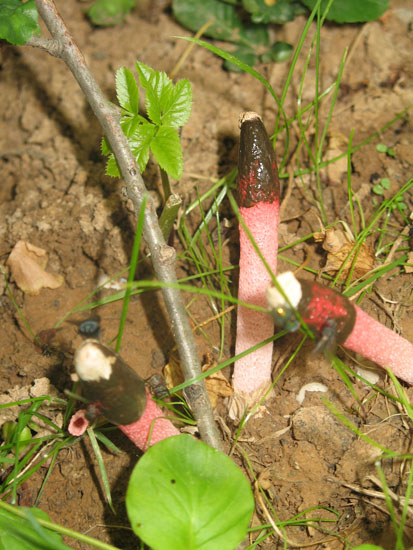
It turned out that the name of the American botanist and mycologist Henry William Ravenel (1814-1887) is well known in a narrow circle of mushroom lovers in the scientific sense. For twenty years of his life, Ravenel worked as a planter in South Carolina, and then devoted himself to scientific activities. Ravenel is one of the pioneers in compiling descriptions of American mushrooms and their classification in accordance with the ideas of the 19th century. In honor of him, not only the mutinus and the bullet gun are named, but also the whole genera of mushrooms - Ravenelia and Ravenelula. As they say, young people on the note - to perpetuate their name, it is not necessary to fly into space, sometimes it is enough to competently describe some stink.
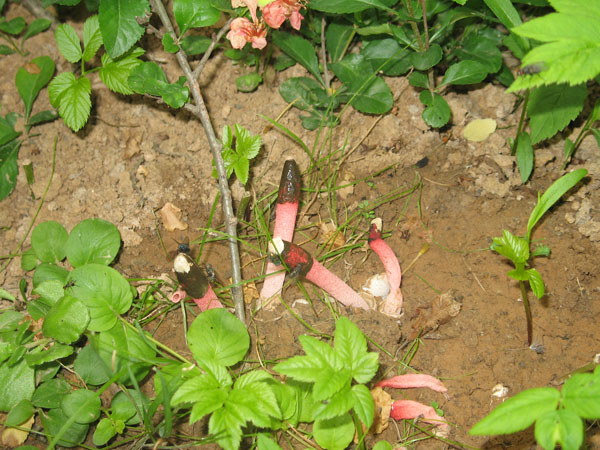
The mutinus Ravenel colony lived on my lawn for about 7 days. Every day in the morning, from one to three new mushrooms were discovered, by lunchtime flies flew to them from all the neighborhoods, in the afternoon the tubular bodies began to lean to the ground, and then fell. The last eggs of the mushroom plantation were flooded with torrential rains, and they did not grow. A couple of days later, a neighbor complained to me about a strange unpleasant smell, the source of which she could not find. Knowing what to look for, I saw a mysterious source through the fence, but did not enlighten my neighbor. Let the mutinuses continue their march through our dachas.
Text and photo - Lazy Summer Resident, 2015
Mitinus canine - miracle mushroom
Dog mutinus is one of the rarest and most unusual of our mushrooms. Outwardly, with all its appearance, it is very similar to a certain part of the dog's body, it is not clear how sticking out of the ground. I strongly suspect that the mushroom got its specific name precisely by its appearance.Here it is so rare that I have seen it only twice in all my more than thirty years of work in the forest.
Moreover, in one single place - in artificial pine plantations near TsPS-4 (central pumping station) near Kolpin (a suburb of St. Petersburg), on an area of several square meters; growing slightly obliquely out of the ground. The color of its fruiting bodies, at their very base, is pale pink, but the higher, the brighter it is;
at the very top it becomes bright red. Slightly below the tip, where the cylindrical part of the mushroom turns into a pointed cone, a belt of mucus, 1-2 cm wide, of khaki color is noticeable. It is he who is the spore-bearing part of the fruiting body of the fungus. The belt, according to the literature, emits the smell of carrion, which was indirectly confirmed by the flies crawling along it intensively;
but I didn’t want to get down on all fours to smell, and I didn’t want to pick such a rare mushroom. Moreover, it is listed in the Red Book. Therefore, I do not know what, most of all, this smell is similar. It is in such an unusual way, on the legs of flies, that the canine mutinus disperses its spores.
His employees found out the exact location of the mutinus from me. True, I still don't know what kind of card they got. Collecting canine mutinus, as listed in the Red Book, is impossible. You can only admire. Moreover, upon meeting, it leaves an indelible impression, not so much with its beauty, although its color is definitely beautiful, as with its bizarre unusual form, and almost unreality of its existence.
Mutinus usually grows in groups, when I first met, I found three mushrooms. And at the second, in the same place, a year later, there were two of them. Not many, but these mushrooms left a greater impression than thousands of other species of mushrooms. There was a feeling of some kind of unreality, irrationality, as if I got into the fairy tale "Alice in Wonderland".
Canine mutinus is a typical forest mushroom; it loves humid places and rich soil. In our country, it usually grows in deciduous forests, although it is very rare there; rarely found in coniferous plantations, as well as in thickets of shrubs. According to literary descriptions, it can sometimes grow around rotting trees, usually in small groups.
Vladimir Starostin, candidate of agricultural sciences
Other publications of V.A. Starostin look at his personal page Starostin Vladimir Alexandrovich. Publications
Mitinus dog, a rare mushroom in my garden (G. Kazanin)

